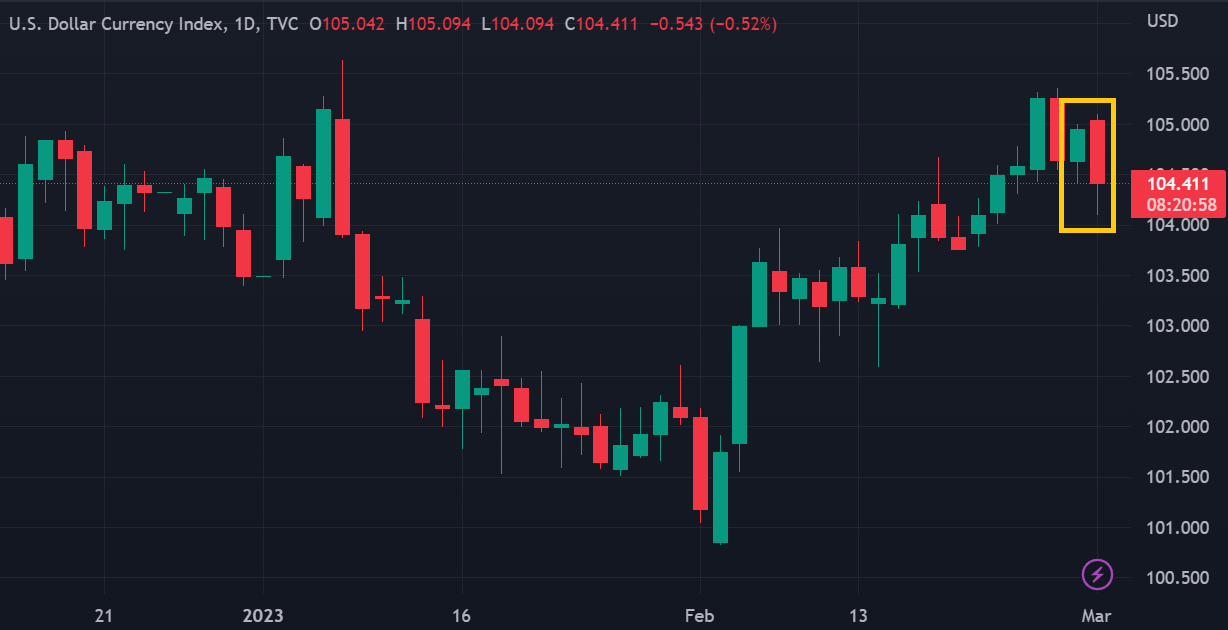The US dollar regained some ground as it entered the New York session, but selling pressure remains significant.
The US Dollar Index (DXY) fell more than half a percent in Wednesday's (March 1) forex market trading due to the release of recent economic data that hurt the greenback. Its position slightly recovered entering the New York session, but selling pressure remained significant.
 DXY Daily chart via TradingView
DXY Daily chart via TradingView
PMI China Boosts Antipodean Currencies
The US dollar in the Asian session was pressured by releasing the latest Chinese Manufacturing PMI data, which exceeded consensus estimates. China's better growth prospects immediately supported risk assets such as the Australian and New Zealand dollars while putting pressure on the US dollar.
"The data (China's PMI today) confirms the expectation that growth prospects have improved significantly enough in China, so it is positive for risk sentiment," said Niels Christensen, chief analyst at Nordea, "This puts the dollar on the defensive."
NZD/USD immediately skyrocketed over 1% to its highest level in a week, while AUD/USD rose to its highest level in the past three days. The euro's appreciation further pressured the US dollar due to indications of rising inflation in the Eurozone.
Inflation in the Eurozone Accelerates Again
A series of regional data released separately during the European session showed an accelerated inflation rate in France and Spain. Inflation data from five German states also remained at their highest levels, with Germany's inflation rate in February still at 8.7% (year-over-year) as in January. This situation raised market expectations for an interest rate hike by the European Central Bank (ECB).
"Inflation data well support euro," said Christensen, as quoted by Reuters, "Tomorrow we are expecting more solid Eurozone inflation data than what we had predicted earlier this week."
ISM Manufacturing PMI Misses in the US
Entering the New York session, the US dollar received an additional blow from the ISM Manufacturing PMI score, which missed slightly. The ISM report showed that the main PMI score fell from 47.4 to 47.7, while the consensus expected an increase to 48.0.
Interestingly, the price component in the PMI report experienced a rapid increase from 44.5 to 51.3 (versus an expected 45.1). This fact supports higher Fed interest rate expectations, causing the US dollar index to crawl from its lowest level at 104.09 to 104.40s.
Sterling Falls Due to BoE Boss Comments
The release of the Purchasing Managers' Index (PMI) data for the UK manufacturing sector briefly pushed GBP/USD to the daily high of 1.2089. Unfortunately, the pair was then derailed by comments from the Bank of England (BoE) chief. BoE Governor Andrew Bailey said the central bank is likely at the end of the monetary tightening cycle.
Bailey's statement erased over half of the sterling's gains this week. At the time of writing, the Sterling is the only major currency that has weakened against the Greenback, with GBP/USD down 0.2% at the threshold of 1.2000. The resolution of the Brexit issue seems unable to provide adequate support for sterling amidst a critical economic situation.

 Dedicated FREE FOREX VPS
Dedicated FREE FOREX VPS Free FOREX Virtual Private Server
Free FOREX Virtual Private Server MT4 Demo Contest, Get $500
MT4 Demo Contest, Get $500 Sign Up for an Account, Claim 60% Deposit Bonus
Sign Up for an Account, Claim 60% Deposit Bonus Free MT4/MT5 VPS 2024
Free MT4/MT5 VPS 2024 Send E-mail and Get Free Merchandise
Send E-mail and Get Free Merchandise $1K Refer a Friend Bonus for Pepperstone Pro clients
$1K Refer a Friend Bonus for Pepperstone Pro clients Maximize Your Earnings with 100% Deposit bonus
Maximize Your Earnings with 100% Deposit bonus Trade to Win, $5,000 Monthly Demo Contest
Trade to Win, $5,000 Monthly Demo Contest Claim 30% + 15% Deposit Bonus from LiteFinance
Claim 30% + 15% Deposit Bonus from LiteFinance






